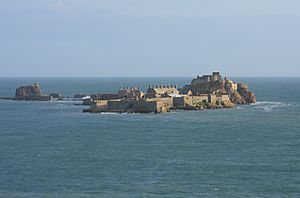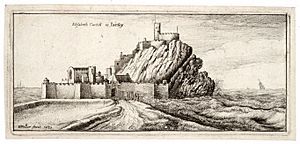Elizabeth Castle facts for kids
Quick facts for kids Elizabeth Castle |
|
|---|---|
| Saint Helier, Jersey | |

Elizabeth Castle at high tide
|
|
| Coordinates | 49°10′30″N 2°07′30″W / 49.175°N 2.125°W |
| Type | Castle |
| Site information | |
| Owner | People of Jersey |
| Controlled by | Jersey Heritage |
| Open to the public |
Yes |
| Condition | Intact |
| Site history | |
| Built | from 1595 |
| Materials | Granite |
| Battles/wars | Battle of Jersey Third English Civil War |
Elizabeth Castle is a famous castle and a fun place to visit in Jersey. It sits on a special island that you can only reach at certain times. This island is in Saint Helier, which is a town in Jersey.
The castle was started in the late 1500s. Back then, powerful cannons were invented. The older castle, Mont Orgueil, wasn't strong enough to protect the island anymore. The port of St Helier also needed protection from enemy ships with cannons.
The castle is named after Elizabeth I, who was the Queen of England when it was being built.
History of Elizabeth Castle
The island where the castle stands was once home to an old church called the Abbey of Saint Helier. Later, the church buildings were used for military purposes.
Building the Castle: 16th and 17th Centuries
Early Construction
Work on the first parts of the castle, called the Upper Ward, began in 1594. This included the Queen Elizabeth Gate. A skilled engineer from Flanders, Paul Ivy, led this building project.
The governors of Jersey, who were in charge of the island, moved their home to Elizabeth Castle. They used to live at Mont Orgueil.
Naming the Castle
Sir Walter Raleigh was the Governor of Jersey from 1600 to 1603. He officially named the castle Elizabeth Castle. He did this to honor Queen Elizabeth I of England.
Expanding the Castle
More parts of the castle, known as the Lower Ward, were built between 1626 and 1636. This area was built where the old church used to be. It became a large open space for soldiers to gather. Around it were buildings for soldiers to sleep and for officers to live. There were also wells and water tanks here.
Elizabeth Castle and the English Civil War
The castle was first used in a real battle during the English Civil War in the 1600s. This was a big fight in England between the King and Parliament.
Prince Charles visited the castle in 1646. He came back in 1649 as King Charles II. He stayed in the Governor's House. The governor, Sir George Carteret, had said Charles was King, even though England had gotten rid of the monarchy.
In 1651, Parliament's army landed in Jersey. They attacked the castle with powerful mortars. The old church, which was used to store gunpowder and food, was destroyed. This forced Governor Carteret to give up on December 15, 1651. The castle had been under attack for seven weeks. Parliament's forces controlled Jersey for nine years until the King returned to power.
A new gate, King William's Gate, was built around 1668. It connects different parts of the castle.
18th Century Conflicts
Seven Years' War
During the Seven Years' War, French prisoners were kept at the castle. One famous prisoner was Jean-Louis Le Loutre.
The castle was involved in another fight in 1781, this time against the French. French soldiers landed in St Helier. The castle's soldiers were stuck on the island. The governor, Moise Corbet, was tricked into giving up to the French. But the castle's soldiers, led by Captain Mulcaster, refused to surrender.
The French were eventually beaten by British troops led by Major Francis Peirson at the Battle of Jersey. Both Peirson and the French leader were killed in this battle.
Because the island seemed easy to attack, a new, stronger fort was built. This was Fort Regent, located on a hill overlooking St Helier. Fort Regent became the main base for British soldiers.
19th Century Changes
In the early 1800s, a two-story hospital building for soldiers was added.
There was a plan to build a huge harbor and connect the castle to the mainland. But this idea was never finished. Today, a long wall, called a breakwater, still connects the island to a rock where Saint Helier's old home is. People use it for fishing.
20th Century: From Military Base to Museum
In 1923, the British government left the castle. They gave it to the government of Jersey. Jersey then opened the castle to the public as a museum.
During World War II, German forces occupied the Channel Islands. They made the castle stronger with new guns, bunkers, and battlements. After the war, the castle was fixed up and opened again for visitors.
Elizabeth Castle Today: 21st Century Events
Every year, around July 16th, people walk to the castle for a special pilgrimage. They hold an outdoor church service inside the castle. Other fun events, like concerts and historical re-enactments, also happen there.
On June 4, 2012, a beacon was lit at the castle. This was to celebrate Queen Elizabeth II's 60 years as queen. A fireworks show followed this event.
Visiting Elizabeth Castle
Today, Jersey Heritage manages Elizabeth Castle as a museum. You can see many historical displays there. One museum shows items from the Royal Jersey Militia, which was Jersey's local army for centuries. Another museum teaches you about cannons and castle defenses.
Every Sunday when the castle is open, actors dress up as soldiers from 1781. They show how soldiers lived and fire muskets and cannons. It's like stepping back in time!
You can get to the castle in two ways. At low tide, you can walk across a causeway from St Helier. When the tide is high, special amphibious vehicles, called Charming Betty and Charming Nancy, take visitors to the castle. These vehicles can drive on land and float on water! A trip when the tide is high takes about 15 minutes.







